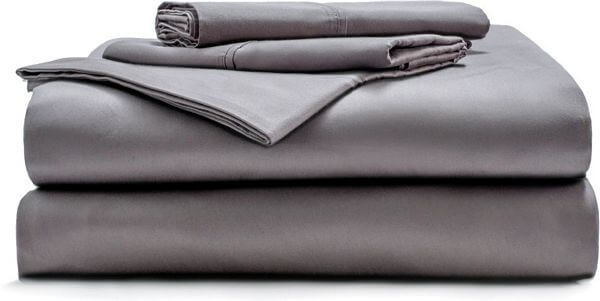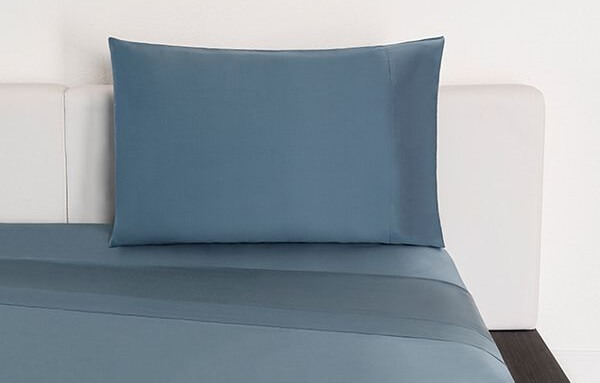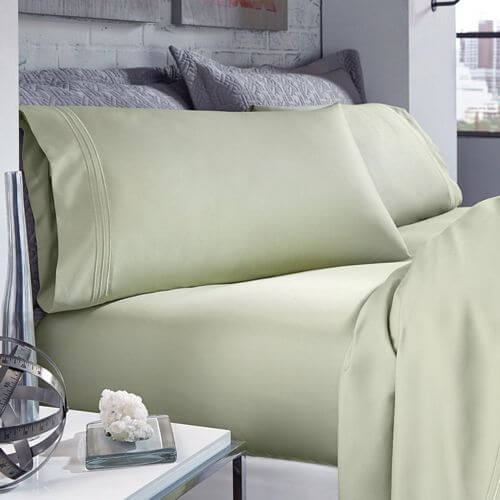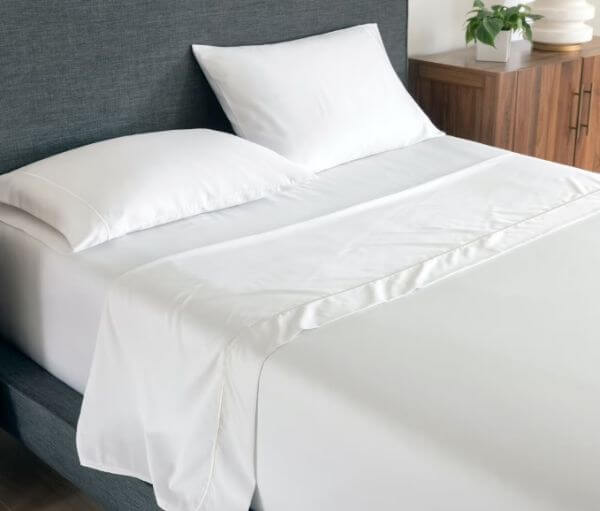There is a tendency to think that the only relevant things in your bad are the mattress and the pillow. However, the bedding also deserves our full attention.
To make sure that you have chosen the best sheets, you will have to pay attention to several questions. The number of threads, the materials with which they are made, their finish and their measurements stand out above all. But there are many other factors, which I discuss in detail below.
Table of Contents
1. The number of threads: is it important or not?
Many believe that the higher the number of threads, the higher the quality of the bed sheets. However, it is more of a myth than a reality. Others, on the other hand, think that we are facing a marketing strategy. Advertising a sheet using the argument that it has more threads per square inch is just one more sales technique.
This is not to say that this factor is not important, it is simply not the only one. But, if we focus on this section, and you want to give it some relevance, you should know that what is determined by the number of threads is the softness or the feel that the sheets will have.
Specifically, if they have between 200 and 400 threads per inch, they will be considered softer sheets. On the other hand, if they do not reach 200 threads, they will not be considered soft, although this does not necessarily mean that their quality is lower.
But, as I already mentioned, the number of threads should not be the only determining factor when choosing between bed sheets. Among other key points, materials and fabrics become even more important.

2. Choose the materials of the sheets carefully
In relation to the number of threads that the sheets contain are the materials with which they are made. Because the longer their fibers are, the more strength they will have when spun.
Even so, there are few occasions in which manufacturers have tried to manipulate their materials and the count of their yarns to make it appear that there is a greater quantity of yarns. We are, without any doubt, facing fraudulent techniques and misleading advertising.
If we focus on the materials, although most sheets are made from cotton, this is not the only optimal material if what you are looking for is the highest quality. These are the most common:
Cotton: Egyptian and Pima are especially noteworthy. Egyptian cotton is considered to be of higher quality and is usually more expensive, as well as more comfortable and durable. The Pima cotton is very smooth and shiny, but cheaper.
Linen: it is characterized by being a very cool material, especially suitable for the warmest nights of the year. But prepare the iron because sheets made with this material wrinkle very easily.
Synthetic materials: although they are not very soft or transpire too much, in exchange you will have cheaper and very resistant sheets. However, if you are looking for maximum quality, it is advisable that the synthetic material contained in the sheets (such as polyester), does not exceed 50% of the composition.
3. Texture or weave is also key
The way in which the material from which a sheet is made is interwoven, joined or combined is also a determining factor in assessing its quality. Not surprisingly, the weave of a sheet directly affects its feel, its appearance and even its possible duration. Of course, all this will also influence its price.
As advice, I recommend that you consider the possibility of purchasing sheets whose fabric is percale. It is a fabric with a neutral and cool feel that is increasingly used, although satin follows closely behind. The latter is considered warmer and softer.
Microfiber, on the other hand, is much denser, so it is usually more difficult for sheets with this fabric to wrinkle or become damaged. As for flannel, it will go a long way to keep you warm in the coldest weather.

4. Evaluate the process and place of manufacture of the sheets
Many experts say something that may seem surprising: even when using the same material, the same number of threads and the same fabric, the quality of the final product can be very different, depending on where the sheets are made. Thus, as paradigmatic examples, France and Italy are considered to be two countries particularly good in the manufacture of all types of textiles.
This is not to say that the material is not important. In fact, Egyptian cotton is considered one of the best in the world. However, the same is not the case with manufacturers in the same country. In this sense, the next time you consider a sheet too expensive, I recommend you look at its place of origin. It is possible that this is the reason for its high price.
As an example, I want to mention one of the processes that not all manufacturers apply to their production of bedding: the combing. It consists of an additional procedure, much finer, in which the aim is to eliminate all impurities.
5. Which finishes are the most comfortable?
So far I have talked about the greater or lesser importance of the threads, the materials, the fabrics and the way in which a sheet is manufactured. However, I can almost certainly say that finishes are the key to everything. Currently, different processes are carried out with different objectives that alter these finishes.
For example, chemical compounds are often used to prevent sheets from wrinkling or shrinking excessively. Surely you know that this can be very uncomfortable on a day-to-day basis. However, these unnatural processes degrade the quality and decrease the lifespan of your sheets.
For this reason, I advise you to use organic materials and manufacturing processes whenever you can.

6. Change the sheets according to the season
You have to understand that sheets are not textiles like towels or curtains. Our body remains in direct contact with them for hours, so, like the clothes we wear every day, they must adapt according to the time of year.
The main reason for this is that materials and their composition have a direct influence on temperature regulation. For example, if you want the air to circulate more and feel a little more cooler while you sleep, it is best to opt for natural fibers.
Synthetic materials prevent perspiration, retaining more heat, and that is why they are more suitable for the colder months.
You also have to take into account, especially when determining how many sets of sheets to buy, that in summer we tend to change sheets much more frequently. In winter, however, we tend to spend more days with the same sheets.
7. How to choose the correct measurements?
Many times this point is not given all the attention it really deserves. However, choosing sheets that do not fit your bed and mattress properly can make your rest less than optimal. Especially when it comes to fitted sheets.
Think about how uncomfortable it can be if this sheet wrinkles under your body while you are sleeping. Or that it gets out of place on the mattress because it is too small. Therefore, it is key that you pay close attention to the width and length of your mattress. In that sense, these are the most frequent sizes:
Width: single beds are usually 80, 90 or 105 centimeters. While double beds reach 135, 150 or 180. The latter are called King Size.
Length: for children, it is usually enough that the bed is 180 centimeters long. Whereas, if the bed is used by adults, it must be at least 190 centimeters, although there are also those of 200 centimeters.
As you can see, today we are lucky to have many different options and measures on the market. You just have to keep in mind that the sheets (both bottom and top sheets) will have to be only slightly larger than the measurements of your mattress.

8. Pay attention to the care and washing of your sheets
Caring properly and as recommended by the manufacturer is vital for sheets to last as good as new for longer. But, in many cases, the required care can be excessive or too demanding.
Therefore, before buying sheets, make sure that their washing and care will not seem too burdensome in the long run. And keep in mind that not carrying for them can lead to certain allergies, a less comfortable sleep or a shorter life of the sheets.
What is certain is that, as a general rule, there are series of care instructions that are considered as basic for all types of sheets. They are the same for all sheets, and are as follows:
- Wash the sheets just when you buy them, before using them for the first time.
- In the warmer months, wash them a couple of times a week. When it is not so hot, it will be enough to do it only once a week.
- Do not use bleach or other abrasive products when washing your sheets, such as chlorine, as they can cause your sheets to wear prematurely.
- Choose intermediate or slow wash cycles to avoid damaging them.
- Whenever you can, let them dry in the sun, so that its effect helps disinfect and whiten your sheets.
9. Make sure they have the best properties
Regardless of the season of the year in which you are going to use your sheets, it is understood that they must have a number of properties to be considered of the highest quality. I’m talking about:
- Breathability: especially important when we are in summer, having breathable sheets will allow us not to notice too much sweat when we are sleeping, because they allow more air to pass through.
- Absorption: absorbing moisture in sheets, preventing both the surface of them and our skin from being damaged, is also essential. And it is achieved with those sheets that have the property of absorption.
- Evaporation: finally, that moisture or that sweat will have to evaporate properly if we do not want to have to wash the bedding very often. And not all sheets offer this property.
It is understood, therefore, that sheets with these properties are “smart”. They themselves react to the different parameters that I have discussed and adjust their “behavior” to them.
10. White or patterned sheets?
It may seem like a trivial question, but it is not. White sheets, without prints, tints, or additives, are able to preserve much more the natural and organic properties of the sheets. For this reason, although for other textiles it is not so important, in this case I do recommend opting for white sheets.
Keep in mind that the manufacturing and production process of a tinted sheet in one or more colors will be longer and more expensive. Therefore, in addition to being more expensive, it will also be more treated. This necessarily means that more chemical products and treatments will be used.
Therefore, if in addition to saving considerably on the purchase of your bedding, you want to be more ecological and environmentally friendly, do not hesitate to opt for white sheets. It is a tip that you should prioritize over the purchase of sheets with fabulous prints, if you want them to last longer and have a more pleasant touch.
Conclusion
We spend more than a third of our lives in bed. Isn’t this reason enough to give all its elements the attention it deserves? After reading all these tips, I’m sure that the next time you choose sheets for your bed you will do so taking into account all the factors that influence their quality.
Quality sheets, made of good materials, breathable, soft and adapted to you and the structure of your bed can make the difference between sleeping and resting.

Alex P. Davis has a BA in Interior Design from The New York School of Interior Design and 10 years of experience expertly designing sophisticated interiors.

